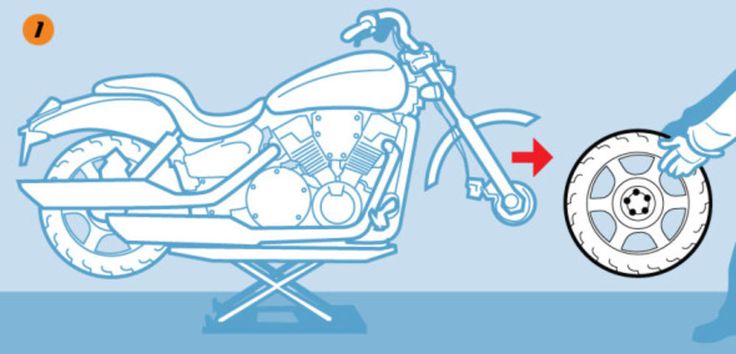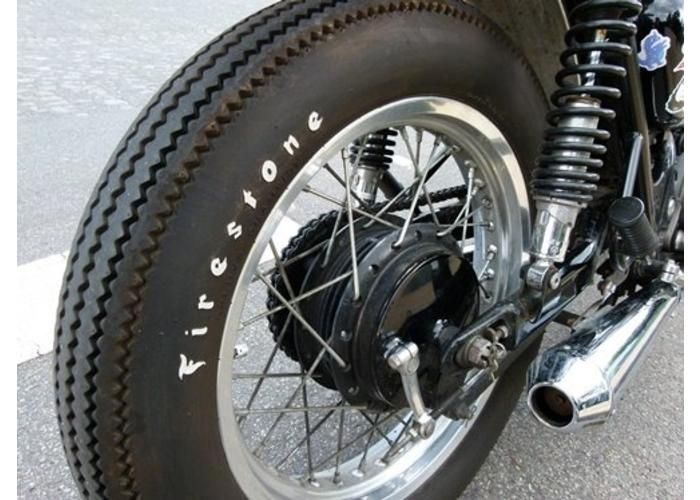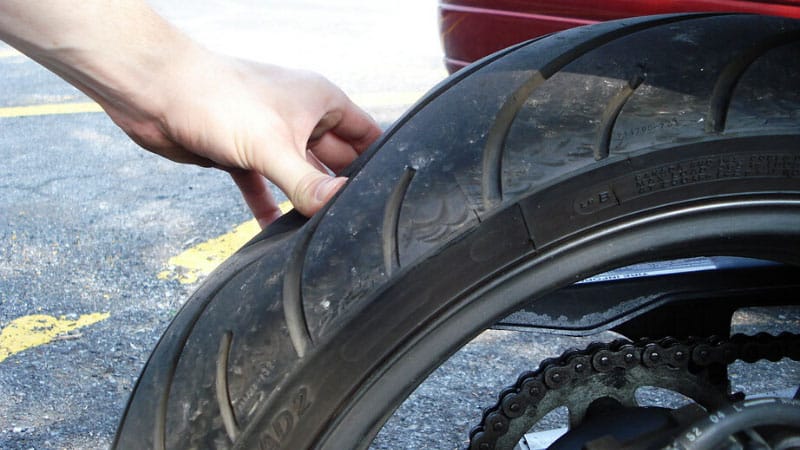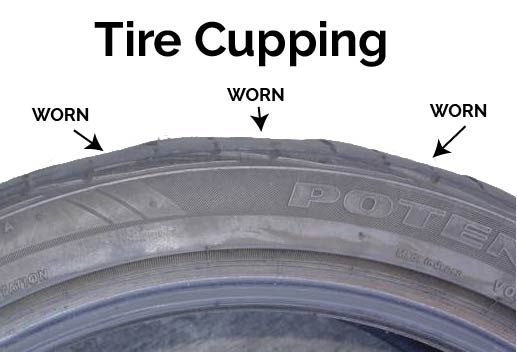Menu
Skip to content
Tips-Tricks
Tip #176 from the pages of The Total Motorcycling Manual
By Mark Lindemann
February 10, 2014Motorcycle tires aren’t just rubber—they’re actually a chemically complex combination of materials designed to work best at specific temperatures. What temperatures? Typically around 165º F (74º C). Not exactly a cool breeze. So how do you get them to be that hot?
There are two ways to do it: by using tire warmers, or by working the tires. The warmers are simple—think of them as custom electric blankets for your tires. Watch any Superbike or MotoGP race on television and you’ll see them on the bikes before they go out on the track—that way the racers get hot tires ready to go from lap one.
Not on the track? Then you’ll have to do it old-school—by working the tire. Ride far and fast enough and the tire will come up to temperature naturally. But you can speed up the process with a series of progressively harder accelerations and stops.
In the old days, riders
used to swerve side-to-side as well, but testing has proven this to be ineffective.
Cycle World's Nick Ienatsch has a great approach: Ride on cold tires as you'd ride in the rain—be smooth, use authority, and make the most of your large inputs with the bike straight up and down—or close to it.
Tips-Tricks
How To Stay Warm On Your Motorcycle
Tips-Tricks
How to Change a Motorcycle Tire
Tips-Tricks
How to Navigate on the Trail without a GPS or Compass
Tips-Tricks
How to Change Your Motorcycle Grips
Tips-Tricks
Get To Know The Safety Features Of Your Motorcycle Boots
Latest
Bikes
10 Great Motorcycles for Travel 2023
Reviews
Piaggio MP3 530 HPE Exclusive First Ride
News
Moto Morini Coming to US
Reviews
2022 Bimota KB4 First Ride
Reviews
Five Great Large-Displacement Naked Bikes for 2023
Bikes
Great Three-Cylinder Sportbikes of Yesterday and Today
News
Honda CL300 Revealed
News
CFMoto 800NK Details
Bikes
Five Most Powerful Bikes Dyno’d in 2022
CFMoto 800NK Details
Moto Morini Coming to US
Great Three-Cylinder Sportbikes of Yesterday and Today
Five Most Powerful Bikes Dyno’d in 2022
Five Weirdest Motorcycles You Can Buy
BMW Shows 100th Anniversary R nineT and R 18 Models for 2023
Reviews
2023 BMW M 1000 R First Ride
First Photos of Harley-Davidson HD350 and HD500
Published: 20 August 2010 Updated: 19 November 2014
1 of 1
With your contact on terra firma reliant on two hand-sized patches of rubber it’s hard to know when your bedded-in tyres are up to operating temperature, but there are a couple of factors that will enable you to know without stopping at the side of the road and feeling them with your hand.
The first is the weather and time of day. You may have heard commentators going on about track temperature at MotoGP, and the fact is that dark tarmac absorbs the sun’s heat very well, so on a sunny afternoon it can be 30-40 degrees C and will transfer that heat into your tyres in a few minutes.
Conversely, a cold winter morning is not going to help you, so the tyres will have to generate their heat themselves and it’s going to take a few miles of quite fast work to generate that heat.
The type of riding you are doing makes a difference. If you are creeping through traffic on wet roads, the tyres will struggle to get warm.
But if you’re on an open road with plenty of curves that allow you to lean left and right and some progressive braking from those relatively high speeds, that’s going to help too.
So, when you come up to that tasty bend, think about what sort of riding you’ve been doing before you tip it in hard.
The closing of the seasons died down, most of the Moscow motorcyclists hid their motorcycles in garages, and only the most desperate riders remained on the roads. Some people just don’t feel cold, some people want to ride as much as possible before a long and cold winter, while others cannot physically “close” – working on a motorcycle has become more and more popular in recent years. Whatever the reasons are not pushing for a deep autumn ride - this material will be useful to you, regardless of the number of successful and not very seasons. nine0003
Some people just don’t feel cold, some people want to ride as much as possible before a long and cold winter, while others cannot physically “close” – working on a motorcycle has become more and more popular in recent years. Whatever the reasons are not pushing for a deep autumn ride - this material will be useful to you, regardless of the number of successful and not very seasons. nine0003
Now, when temperatures drop to minus at night, and barely exceed 1-2 degrees during the day, equipment becomes especially important. Hands, legs and neck will freeze, so they need to be insulated with special care.
Keep your hands warm
Good, warm gloves are a must. There are winter motorcycles on sale, but snowmobiles are also suitable, the main thing is to turn the gas and press the levers comfortably. Uncomfortable to ride in thick gloves? Suitable and simply dense, without ventilation, in the presence of heating of the handles. By the way, the most budget options for “warm” pens will cost about the same as gloves, so the choice is yours. nine0003
nine0003
Heated handles, coupled with protection of the levers and waterproof gloves will ensure hand comfort even in minus
As an alternative, you can consider warm handlebar covers that can be combined with handle protection: in this case, accidental brake and clutch pressing are excluded. And if you don’t have any money at all, here’s a life hack shared by experienced riders: take cheap rubber boots, or better, old felt boots, cut off the toes from them and put them on the handlebars through the resulting holes. Tape on and enjoy wind protection and comfort even in sub-zero temperatures. The main thing is to be careful during installation - in the extreme positions of the steering wheel, such “tuning” should not cling to anything and under no circumstances should it compress the brake and clutch levers. nine0003
Anti-fog visor
The head will be warm in any integral helmet, so all helmet tuning should be reduced to installing a pin-lock visor or, if one is not available, treating the glass with a special anti-fog compound. As an alternative, consider buying a snowmobile helmet with double glazing and a heated visor.
As an alternative, consider buying a snowmobile helmet with double glazing and a heated visor.
Read also:
Everything you need to know about choosing a motorcycle helmet
But in the neck it will blow especially hard - buy a windstopper, a balaclava or wrap yourself in a scarf. Any of these solutions will significantly increase comfort, especially on long hauls.
Anti-fogging visor can be treated with sprays, pinlock, double glazing or heated visor
There are fewer and fewer motorcyclists on the roads, which means that other road users are starting to look less often in the mirrors. In addition, daylight hours are getting shorter, and you have to drive at dusk. That's why feel free to growl, wear a bright reflective road worker's vest, and flash your high beams. This is not rudeness, but a way to survive. nine0003 As we have already said, every day drivers are less and less ready to meet you. However, the dangers do not end there - on cold asphalt, the rubber warms up much worse and the “hold”, if it does not disappear completely, then significantly decreases even on a dry surface. With the advent of cold weather, the braking distance increases greatly, and braking itself sometimes becomes very unpredictable. It is a little easier for owners of motorcycles equipped with ABS and traction control in this regard - electronics take over part of the work, but in percentage terms there are not many such lucky ones. That's why forget about sharp throttle openings in corners, efficient decelerations and deep leans into corners. nine0003 At the same time, it is necessary to slow down the average speed. Of course, this will increase the risk that, for example, you will be rebuilt, but in this case you have to choose between two evils. And be careful in the aisle - there you can often find markings, on which you can slip in the rain and with a slight plus even on good tires. nine0003 Turning is a different story. On a slippery road, you need to lay down the motorcycle as little as possible, for which the pilot will have to hang more into the turn. In fact, your task is to leave the motorcycle in the most vertical position, compensating for the effect of centrifugal force with your own body. The more you hang, the more vertical the motorcycle remains, the more difficult it will be for him to leave from under you. It is clear that the motorcycle will look worse from trips in the fall, so all fans of the off-season can be advised to wash the motorcycle at least once a week, and then fill it with some kind of conservation lubricant, even silicone, even penetrating. This will partially save the situation. nine0005 Read also: Introduction What is the pressure in motorcycle tires? How to properly set tire pressure? What is the result of under/over pressure in motorcycle tires? nine0003 Conclusion Handling and maneuverability on dry and wet surfaces; The size of the contact patch is directly responsible for traction; Suspension workload; Fuel consumption; Wear resistance. In short, only correctly inflated tires can do their job well - to maintain contact with the track and not lose it throughout the entire trip. Any deviation from the norm (lack or excess of pressure) is fraught with unpleasant consequences. The manufacturer indicates all parameters of cold rubber inflation on the table on the motorcycle frame or in the user manual. They vary depending on the type of motorcycle, but, as a rule, the data varies between 2.0-2.5 atm for the front wheel and 2.2-2.9Atm for rear. If you plan to put another person on the bike, we recommend inflating the tires by 0.2 atm. Wheel size Pressure, front/rear, kgf/cm2 (atm) Normal load Full load 100/60-10 2. 2.3/2.4 130/60-13 1.8/2.0 2.0/2.2 130/70-12 2.2/2.3 2.3/2.4 120/70-12 2.25/2.3 2.3/2.4 110/70-12 2.2/2.3 2.3/2.4 120/80-12 1.8/2.0 2.0/2.2 130/70-10 1.8/2.0 2.0/2.2 100/90-10 1.9/2.1 2.0/2.2 120/90-10 1.8/2.0 2.0/2.2 130/90-10 1.9/2.1 2.0/2.2 3.0×10 1.75/2.0 2. 3.50×10 4PR 2.5/2.5 2.6/2.6 To begin with, inflate the tires to 2-2.3 atm, given that for the rear tire the pressure should always be 0.3 atm more than for the front. Ride at your normal pace for 10-15 minutes. The pressure in the rear and front tires should increase by an average of 0.2 atm. Then use the pressure gauge again: if it shows a value within the normal range of cold pressure, then you have achieved your goal. If it is higher, then lower the wheels, if lower, pump up. Measure tire pressure and adjust the amount of air inside until you get the result. nine0003 If you notice a slight discomfort immediately after the start, this is normal. Increased tire pressure is used only in two cases: if there is another passenger on the motorcycle or during long high-speed races. Under-inflated tires have their own list of problems: their contact patch may be larger, but due to its irregular shape, it wears out and deforms extremely quickly. Riding on underinflated tires is practiced only on special enduro sports bikes for off-road stunts. However, in order to calmly control a motorcycle, it is not enough just to set the correct tire pressure and calm down on this - we also recommend that you refer to the speed index table. Speed index Maximum speed, km/h A 40 B 50 C 60 65 E 70 F 80 G 90 J 100 K 110 L M 130 N 140 P 150 Q 160 R 170 S 180 T 190 U 200 H 210 V 240 W 270 Y 300 VR >210 ZR >240 (W) >270 Z >300
Get the right gear a set of good tourist equipment and winter thermal underwear. And if it's cold, buy the cheapest pants on a synthetic winterizer and a simple padded jacket in a workwear store. It looks creepy, but it will be extremely difficult to freeze. nine0003
To protect your body from the cold, you can use a set of hiking equipment and a raincoat
Take care of the warmth and dryness of your feet . That is why it is better to choose tight tourist boots without ventilation and warm socks, and to keep your feet dry, you can glue a couple of women's pads on the insoles - they absorb moisture well. nine0003
nine0003
Waterproof warm boots will come in handy not only in autumn-winter, but also during rainy summer
Become more noticeable
In rainy autumn twilight, do not neglect additional lighting and bright equipment
Remember the cold asphalt  What can we say about rain, snow, mud, slippery rotten leaves and shampoos that are used to treat roads before winter. And this is without taking into account the fact that by November, the motorcycle is shod with tires installed, at best, at the beginning of summer! nine0003
What can we say about rain, snow, mud, slippery rotten leaves and shampoos that are used to treat roads before winter. And this is without taking into account the fact that by November, the motorcycle is shod with tires installed, at best, at the beginning of summer! nine0003
A good safety net on wet and cold asphalt will be fresh rain tires
Accelerate smoothly
Autumn is the time to remember the rules for moving on slippery surfaces
Slow down the pace  Experienced riders and owners of modern motorcycles can be advised to limit themselves to the notorious +20 from the flow rate, and generally slow down to car speeds for everyone else.
Experienced riders and owners of modern motorcycles can be advised to limit themselves to the notorious +20 from the flow rate, and generally slow down to car speeds for everyone else.
Wet fallen leaves and fresh markings can play a cruel joke on an unprepared motorcyclist
Do not tilt the motorcycle  nine0003
nine0003
On a slippery road, it is necessary to keep the motorcycle in the most vertical position - work with your body
Prepare the motorcycle
How to buy a motorcycle and not make a mistake - 50 tips for choosing used equipment
It is especially important to do this before wintering - if you park a motorcycle covered with salt and reagents, even in a warm garage, you are at great risk. Most likely, in the spring you will return to something that looks more like a coral reef of brown rust and white oxides on aluminum. It is clear that in most cases it will be possible to put things in order and restore their former gloss, but these procedures will cost much more than a banal washing and conservation. nine0003
nine0003
When driving actively in autumn, it is worth washing the motorcycle from salt and reagents at least once a week
Following these simple guidelines is a great way to extend your riding season by a couple of months. However, if traveling on the roads has become boring, you should pay attention to off-road trips - for the happy owners of motorcycles of the “enduro” system, the concept of “season” actually does not exist.
Subscribe to Omoimot on Vkontakte, Facebook, Google+ or Twitter to be the first to receive announcements of the most interesting materials where it is convenient for you. nine0003
Cover photo - Matthew Jones
Photos in the article belong to their authors what should be the pressure in motor tires, table
The safety and reliability of riding a motorcycle depends not only on which tires are used, but also on what level of pressure is maintained inside. It is very dangerous to treat this carelessly. And why and how to correctly calculate the pressure in motorcycle tires - read our article and find out.
It is very dangerous to treat this carelessly. And why and how to correctly calculate the pressure in motorcycle tires - read our article and find out.
Air, like any substance, expands when heated and contracts when cooled. This is also true for motorcycle tires - when hot, one level of pressure is maintained inside the tires, and when it is cold, it is completely different. Tire pressure is important, as it is responsible for the most important characteristics for any bike - both scooter and sport enduro:
 nine0003
nine0003
Front and rear tires should have different pressures and this is important to understand before handling the pump. The owner's manual of any bike always indicates the optimal pressure for cold tires, so if you measure the indicators immediately after the ride, do not be surprised that the pressure gauge will show different values - the air inside has warmed up and expanded.
nine0227  2/2.3
2/2.3 nine0227 nine0227 nine0227  0/2.1
0/2.1
Hot pressure depends on many factors up to the riding style of the rider, so they will have to be selected individually for each specific case:
 The rubber needs to warm up a little and after five minutes everything will return to normal.
The rubber needs to warm up a little and after five minutes everything will return to normal.
If you overinflate your tyres, get ready for the contact patch to decrease, and with it the traction to deteriorate, the ride will become much stiffer, there will be a chance of vibration, and the load on the suspension will also increase significantly. Riding in over-inflated tires on a wet road is quite dangerous, because due to the small contact area, the motorcycle will begin to skid in corners and brake poorly. The most unpleasant consequence will be a deterioration in strength and wear resistance. Motoshina can even explode when driving on hot asphalt - one pebble can cross out everything. nine0003  Of the useful qualities of rubber, handling, maneuverability, directional stability and fuel consumption are seriously affected. In the end, if you do not correct the pressure in the motorcycle tires, everything will end with a cord detachment. If your motorcycle has wheels with chambered tires, then insufficient inflation of the chambers will sooner or later lead to accidental disassembly. nine0003
Of the useful qualities of rubber, handling, maneuverability, directional stability and fuel consumption are seriously affected. In the end, if you do not correct the pressure in the motorcycle tires, everything will end with a cord detachment. If your motorcycle has wheels with chambered tires, then insufficient inflation of the chambers will sooner or later lead to accidental disassembly. nine0003
nine0002 120 nine0227
It is forbidden to put tires with a low speed index on high-speed motorcycles - they may not cope with the capabilities of the motorcycle, which will not lead to anything good.